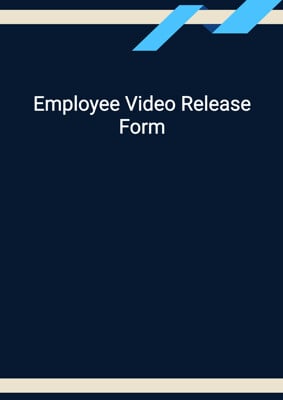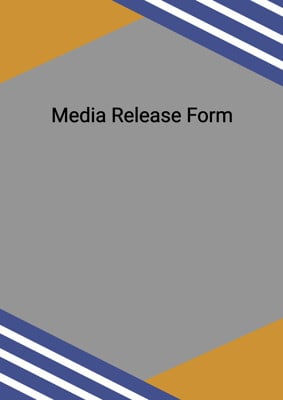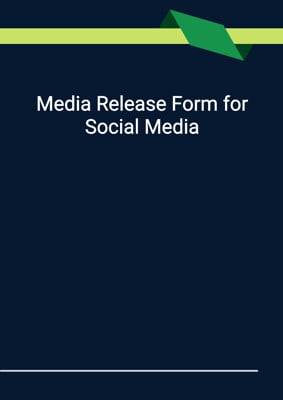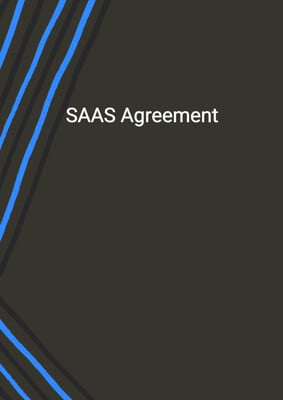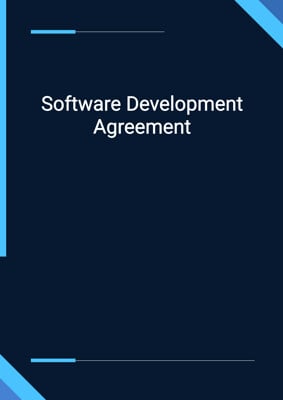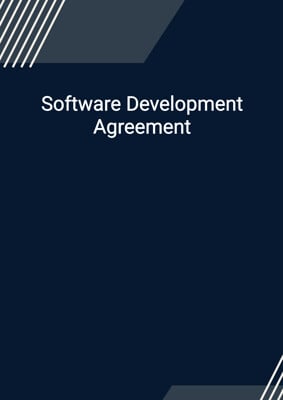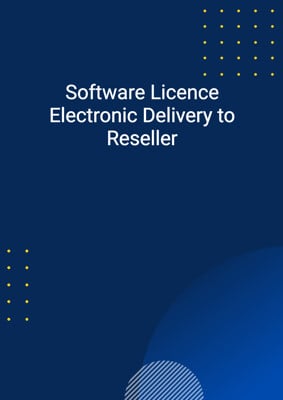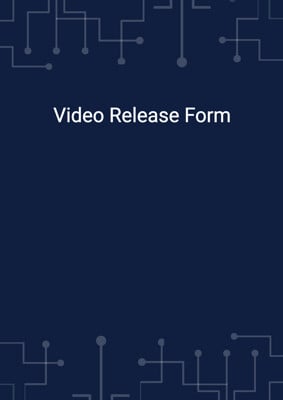How to Tailor the Document for Your Need?
01
Create Document
Fill in the details of the parties. You can click the "Fill with Member’s Information" button to complete it with information saved to your account.
02
Fill Information
Please fill in any additional information by following the step-by-step guide on the left hand side of the preview document and click the "Next" button.
03
Get Document
When you are done, click the "Get Document" button and you can download the document in Word or PDF format.
04
Review Document
Please get all parties to review the document carefully and make any final modifications to ensure that the details are correct before signing the document.
Document Preview
Document Description
A SaaS agreement, or Software as a Service agreement, is a legally binding contract between a SaaS provider and a customer. The SAAS terms and conditions governing the use of the software provided by the SaaS company.
Importance of a SaaS Agreement:
- Legal Clarity: A SaaS agreement establishes the legal relationship between the provider and the customer, reducing the risk of disputes.
- Service Scope: Clearly defines the scope of the services, ensuring both parties have a mutual understanding of what is being offered.
- Data Security: Outlines the security measures in place to protect user data, addressing concerns related to privacy and compliance.
- Payment Terms: Clearly specifies the cost structure, payment frequency, and any additional fees, preventing misunderstandings.
- Termination Terms: Describes the conditions under which the agreement can be terminated, protecting the interests of both parties.
What's in this SaaS Agreement Template:
- License Grant:
Specifies the rights granted to the customer for using the software. Outlines any limitations on usage, such as the number of users or devices.
- Service Level Agreement (SLA):
Defines the level of service the SaaS provider commits to, including uptime guarantees and support response times.
- Data Security and Privacy:
Describes the measures taken to secure and protect user data.
Addresses compliance with data protection regulations such as GDPR.
- Payment Terms:
Clearly outlines the pricing structure, payment frequency, and any applicable taxes or fees.
Describes the consequences of late payments or non-payment.
- Intellectual Property Rights:
Clarifies ownership of intellectual property, ensuring that the customer does not infringe on the provider's rights.
- Termination and Renewal:
Outlines the conditions under which the agreement can be terminated by either party.
Discusses options for renewal and any associated terms.
Here's more about this SAAS printable template section wise:
The entire document is divided into several sections, each serving a specific purpose. The first section, titled 'Interpretation', provides definitions for key terms used throughout the agreement. This ensures that both parties have a clear understanding of the terminology used.
The second section, titled 'Responsibilities', outlines the responsibilities of both the Company and the Client. The Company agrees to provide the services in a professional and diligent manner, while the Client is responsible for registering for an account and keeping their login details confidential.
The third section, titled 'License to Use the Services', grants the Client a nonexclusive, non-assignable, royalty-free license to access and use the services for their internal business operations. It also clarifies that the Company retains all intellectual property rights to the software and reserves the right to take action against any infringement.
The fourth section, titled 'Restrictions', sets out the limitations on the Client's use of the services. These include restrictions on copying the software, reverse engineering, and removing copyright notices. Any unauthorized use of the services terminates the licenses granted by the Company.
The fifth section, titled 'Payment Terms', outlines the payment obligations of the Client. It specifies the fees to be paid, the payment schedule, and the consequences of late payment. The fees exclude any applicable taxes, which are to be paid separately by the Client.
The sixth section, titled 'Intellectual Property', states that the Company owns all rights, title, and interest in the services and the software. It also disclaims any warranties and limitations of liability for the use of the software and services.
The seventh section, titled 'Limitation of Liability', limits the liability of the Company and its affiliates for any loss or damage resulting from the use of the services. It specifies that the total aggregate amount of liability shall not exceed certain limits.
The eighth section, titled 'Indemnification', states that the Company agrees to indemnify the Client against any claims arising from third-party claims of infringement or negligence.
The ninth section, titled 'Customer Data', clarifies that the Customer owns and accepts responsibility for any data processed or submitted to the service. It also specifies that the Customer is responsible for ensuring compliance with applicable laws and obtaining any necessary consents.
The tenth section, titled 'Liability Disclaimer', disclaims any responsibility for suspension or interruption of the service, guarantees the stability and uninterrupted use of the system, and disclaims any warranties for the software and services.
The eleventh section, titled 'Confidential Information', imposes obligations on both parties to keep the terms of the agreement and any confidential information confidential, subject to certain exceptions.
The twelfth section, titled 'Term and Termination', specifies the duration of the agreement and the conditions for termination. It also states that certain obligations and restrictions will survive the termination of the agreement.
The thirteenth section, titled 'Force Majeure', states that neither party shall be liable for any delay or failure to perform their obligations under the agreement due to events beyond their control.
The fourteenth section, titled 'Assignment and Other Dealings', prohibits the assignment or transfer of rights and obligations under the agreement without prior written consent.
The fifteenth section, titled 'No Partnership or Agency', clarifies that the agreement does not establish a partnership or agency relationship between the parties.
The sixteenth section, titled 'Waiver', states that no failure or delay in exercising any right or remedy under the agreement shall constitute a waiver of that right or remedy.
The seventeenth section, titled 'Entire Agreement', states that the agreement constitutes the entire agreement between the parties and supersedes any previous agreements or understandings.
The eighteenth section, titled 'Severance', provides for the modification or deletion of any invalid or unenforceable provisions of the agreement.
The nineteenth section, titled 'Notices', specifies the methods and deemed times of giving notice between the parties.
The twentieth section, titled 'Counterparts', allows the agreement to be executed in multiple counterparts.
The twenty-first section, titled 'Right of Third Parties', states that third parties have no right to enforce any terms of the agreement.
The twenty-second section, titled 'Arbitration and Proper Law', encourages the parties to resolve any disputes amicably and specifies the proper law governing the agreement.
The twenty-third section, titled 'Jurisdiction Clause', provides for the jurisdiction of the courts in case of any disputes.
The SAAS Agreement is a comprehensive document that covers all aspects of the relationship between the Company and the Client regarding the use of software as a service. It ensures that both parties have a clear understanding of their rights and obligations and provides a framework for resolving any disputes that may arise.
Not Sure about SAAS Agreement yet? Read our comprehensive guide to SAAS Agreement
How to use this document?
1. Register for an account: The Client must register for an account via the website to access the services and software. Keep the account login details confidential to maintain security.
2. Understand responsibilities: Familiarize yourself with the responsibilities outlined in the agreement. The Company agrees to provide the services in a professional and diligent manner, while the Client is responsible for maintaining equipment and ancillary services needed to use the services.
3. License to use the services: The Client is granted a nonexclusive, non-assignable license to access and use the services for internal business operations. Understand that this license will automatically terminate if the agreement is terminated.
4. Restrictions on use: Be aware of the restrictions on copying the software, reverse engineering, and removing copyright notices. Any unauthorized use of the services terminates the licenses granted.
5. Payment terms: Understand the payment obligations, including the fees, payment schedule, and consequences of late payment. Ensure timely payment to avoid suspension of services.
6. Intellectual property rights: Acknowledge that the Company owns all rights, title, and interest in the services and software. Respect the intellectual property rights and refrain from infringing on them.
7. Limitation of liability: Be aware of the limitations of liability for the Company and its affiliates. Understand that the total aggregate amount of liability is capped.
8. Indemnification: Know that the Company agrees to indemnify the Client against claims arising from third-party claims of infringement or negligence.
9. Customer data: Understand that the Customer owns and accepts responsibility for any data processed or submitted to the service. Ensure compliance with applicable laws and obtain necessary consents.
10. Confidentiality: Maintain the confidentiality of the terms of the agreement and any confidential information disclosed. Exceptions apply as specified in the agreement.
11. Term and termination: Familiarize yourself with the duration of the agreement and the conditions for termination. Certain obligations and restrictions will survive termination.
12. Force majeure: Understand that neither party shall be liable for any delay or failure to perform obligations due to events beyond their control.
13. Assignment and dealings: Obtain prior written consent for any assignment or transfer of rights and obligations under the agreement.
14. Entire agreement: Recognize that the agreement constitutes the entire agreement between the parties and supersedes any previous agreements or understandings.
15. Severance: Understand that any invalid or unenforceable provisions of the agreement may be modified or deleted.
16. Notices: Follow the specified methods and deemed times for giving notice between the parties.
17. Counterparts: Understand that the agreement may be executed in multiple counterparts.
18. Right of third parties: Note that third parties have no right to enforce any terms of the agreement.
19. Arbitration and proper law: Attempt to resolve any disputes amicably and in good faith. The proper law governing the agreement is specified.
20. Jurisdiction clause: Be aware of the jurisdiction of the courts in case of any disputes.
Not the right document?
Don’t worry, we have thousands of documents for you to choose from:


